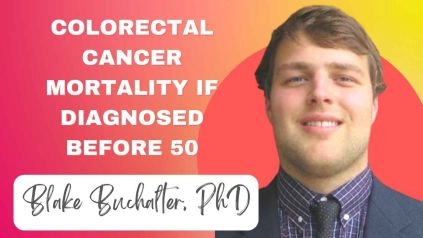We completed a geospatial epidemiological study, examining colorectal cancer mortality among those diagnosed before the age of 50. And this is also known as young onset colorectal cancer. So rates of young onset, colorectal cancer, incidents and mortality have been rising rapidly since the mid-nineties with largely unknown patterns and cause.
We used data from the underlying cause of death database from CDC wonder for the years, 1999 to 2019 to identify geographic hot and cold spots of young onset colorectal cancer mortality in us counties. So, the overarching result that we found was that geographic patterns of mortality among the youngest colorectal cancer patients.
So, those younger than 35 years old, differs substantially from even slightly older, young onset colorectal cancer patients that are in the 35 to 49 year old age category among the youngest patients, we found notable hotspots in the Midwest and also the great lakes region, but no Southern patterns that we found in all other age categories.
Also, the older 35 to 49 year old population had mortality hotspot patterns, more similar to average onset colorectal cancer, or those diagnosed at 50 years and older. This indicated to us that mortality among the youngest patients may be driven by a distinct set of factors, such as more aggressive biology that are synced even from slightly older patients, such as those in their forties.
So, I think the main comment or interest that we get from clinicians specifically is how we went about identifying mortality hotspots. So, by training, I am actually a geospatial epidemiologist. So, I use GIS methods and geographic analysis tools to examine trends, patterns, and spatial correlates of disease.
So, for this study, we use something called spatial scans, which uses a moving window of circles of various sizes to basically scan over a geographic study area, to identify areas where mortality rates were significantly higher or lower than expected.
This is one of the first handful of studies, examining geographic patterns of young onset colorectal cancer outcomes. And we view what we found as more of an impetus to study specific regions more deeply from a clinical standpoint. And because this one was an ecological study; we view our results less as directly.
Applicable to clinicians in their practice currently, and more is a way to spur clinical research in certain regions.
So, the next steps from here are to one, use more granular individual level data, both at the state level, and nationally to see how ecological hotspot patterns we identified hold up when integrating data from individual patients and then two integrate. Other young onset colorectal cancer outcomes when doing these sorts of analyses, such as incidents specifically.
And finally, we want to use, we want to use this same individual level data to begin piecing together underlying causes of the alarming rise in incidents and mortality of young onset, colorectal cancer.
I do think we’ve mostly hit the high points of our study, but I do wanna take a moment to thank the oncologists and hematologists Dr. Khorana, Dr. Kamath, Dr. Nair that were co-authors on this study because they were absolutely crucial in helping us integrate clinical principles when interpreting our results.
Blake Buchalter, Ph.D., is a postdoctoral fellow in Dr. Schmit’s lab and the lab of Jesse Schold, PhD, in the Department of Quantitative Health Sciences at the Cleveland Clinic Learner Research Institute. In this video, he speaks about the article Researchers Discover Young-Onset Colorectal Cancer Mortality Hot and Cold Spots.
According to a research letter published in Gastroenterology, a new study led by Lerner Research Institute and the Center for Young-Onset Colorectal Cancer at Cleveland Clinic has identified geographic patterns of high and low mortality rates of young-onset colorectal cancer (yoCRC) in the United States. The findings will help to increase understanding of the underlying causes of yoCRC mortality and may aid in policy conversations about screening criteria and region-specific interventions.
The researchers used colorectal cancer-specific mortality data from 3,036 counties in the United States between 1999 and 2019. Age, gender, race/ethnicity, obesity, smoking, alcohol usage, and socioeconomic situations were all taken into account when developing the geographic clustering models. They looked at two broad age-at-diagnosis groups: younger than 50 and older than 50, as well as four stratified groups: younger than 35, 35 to 49, 50 to 64, and older than 65.
Notably, they detected new mortality hot places in the Midwest/northeast Great Lakes region, the first reporting of yoCRC mortality hot spots in these areas, as well as cold spots in western/southwestern counties with a decreased risk of yoCRC death. They also discovered death hotspots in southern and Appalachian areas for people under the age of 50, which was consistent with earlier research. However, they discovered that hot regions in those aged 35 to 49 closely resembled southern patterns reported in average-onset CRC, whereas hot spots in those younger than 35 did not, implying that fatalities among the youngest yoCRC patients may be driven by a different set of causes.

